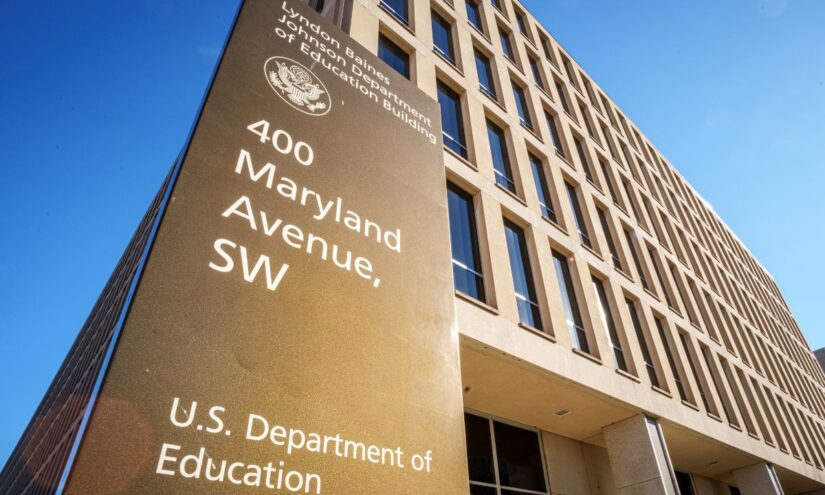Get stories like this delivered straight to your inbox. Sign up for The 74 Newsletter
Despite the fiery rhetoric, President Donald Trump’s push to eliminate a Department of Education he accuses of abusing “taxpayer dollars to indoctrinate America’s youth” comes down, appropriately, to civics and math.
First, the president cannot legally abolish a department with statutory responsibilities embedded in the law. Only Congress can do that.
Most of the public money that flows to the department goes to programs codified in federal legislation. They include Title I ($18 billion annually), special education ($15 billion) and the Office for Civil Rights ($140 million).
To eliminate any of those programs — let alone, to shutter the department outright — or even to move them to another agency, requires a supermajority in Congress. That means six Democrats and every Republican in the Senate would need to be on board. The political calculus is daunting.
That leaves a motley assemblage of much smaller programs that are not bound up in Congress’s authority. Michael Petrilli, president of the conservative Thomas B. Fordham Institute, described those offerings as relative “pocket change” compared to the department’s overall budget.
“I think it’s going to be pretty slim pickings,” he said.
One notable exception would be the Office of Planning, Evaluation and Policy Development, which had almost 130 employees as of the end of December. Congress did not authorize the office, “so it could get axed before 5 today if they wanted,” said David Cleary, a principal with The Group, a Washington lobbying firm and a former Republican education staffer for the Senate. Even this program has functions, like safeguarding student privacy, that only Congress can eliminate.
Trump’s inner circle appears to have reckoned with its legal limitations in an executive order the president is expected to sign before the end of the month. Cleary is among those who was briefed on a draft that would call on lawmakers to eliminate the agency while Trump’s yet-to-be-confirmed education secretary does her part to push out staff and offload functions to other agencies.
“The executive can’t just reorganize or change the authorities on its own,” Cleary said. Laws like the Education Sciences Reform Act and the Elementary and Secondary Education Act “empower and constrain the department in various ways.”
Two other sources, who either saw early drafts or an outline of the proposal and asked not to be named because of ongoing work with the department, agreed the order will take a two-part approach. The Wall Street Journal first reported on the deliberations Monday.
Some members of Congress are eager to help. A bill from South Dakota Sen. Mike Rounds would shutter the agency over a six-month timeline. And Republican Rep. Thomas Massie of Kentucky reintroduced a one-sentence bill on Friday that aims to close the department by the end of 2026.
But with those proposals unlikely to get the required votes, experts say there’s little Linda McMahon, Trump’s nominee to lead the department, can do on her own. In addition to legislation establishing the department in 1979, other laws, like the Higher Education Act and the Individuals with Disabilities Education Act, authorize what the department does and how much it spends.
Petrilli recalled that the first Trump administration eliminated the Office of Innovation and Improvement, which he helped create when he was a department official during President George W. Bush’s administration. The Blue Ribbon Schools program, which recognizes exemplary schools and costs about $100,000 a year to run, could be targeted this time. In keeping with Trump’s executive order against diversity, equity and inclusion, any grants highlighted in a recent report from Parents Defending Education, a conservative advocacy group, would also likely be cut. Those total about $1 billion. Staff connected to DEI efforts have been among the first to be dismissed.
Trump’s team is unafraid to push the envelope, as it has shown with the move to shut down USAID, but Petrilli doesn’t expect Trump’s Department of Government Efficiency to find much else to eliminate without Congress’s OK.
“This is the big action,” he said of DOGE staff digging into department databases over the weekend. “Then it’s going to be over and they’re going to be on to other things.”
The administration doesn’t have the same level of hostility for the education department as it does for foreign aid programs, added Jim Blew, who served under former Education Secretary Betsy DeVos during Trump’s first term and co-founded the conservative Defense of Freedom Institute.
“USAID sends money overseas, and people don’t understand how that’s in the U.S.’ interest. “I think the White House is reading those tea leaves,” he said. “It’s different for the department. I don’t think the dynamics are the same.”
But he hasn’t written off the idea that Trump could convince enough members of Congress to wind down the department and shift major programs to other agencies. While a recent poll showed a majority of Americans don’t want the department eliminated, there are limits to that support.
“Congress is very frustrated with the amount of money spent and the lack of results,” he said. “That always creates this inflammatory environment.”
The question is whether moving special education to the Department of Health and Human Services, for example, or shifting career and technical programs to the Department of Labor would result in less spending and bureaucracy, said Julia Martin, director of policy and government affairs with The Bruman Group, a Washington law firm.
Proponents of closing the department, like Sen. Rounds, haven’t provided those details. His bill would send K-12 funding to the states as a block grant, but offered no specifics on how to do it.
If Rounds gets his way, she added, states and districts might not receive the same attention they do now.
“Despite our occasional frustrations, [the Education Department] has … historically been a user-friendly and responsive agency,” she said. “Having a new agency that is inexperienced and understaffed increases the potential for fraud, waste, and abuse, and decreases responsiveness.”
Some observers speculate that Trump is delaying his executive order so McMahon won’t have to face pointed questions from the Senate education committee over how to implement it.
Related
Trump Orders Expanded Private School Choice, an End to ‘Radical Indoctrination’
While the fate of the department is unclear, the uncertainty over which programs would be cut is creating fear and chaos, said Keri Rodrigues, president of the National Parents Union.
“There is a lot of toxic distraction right now,” said Rodrigues, who plans to meet with Chief of Staff Rachel Oglesby on Thursday. “What are the priorities? I would like to hope that they have a forward-looking vision for the future of education.”
Get stories like these delivered straight to your inbox. Sign up for The 74 Newsletter









The Real Costs of ICE Raids at Schools – And What Educators Should Do – The 74
Posted 0 mints ago by inuno.ai